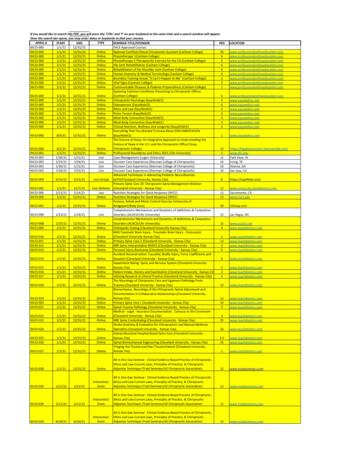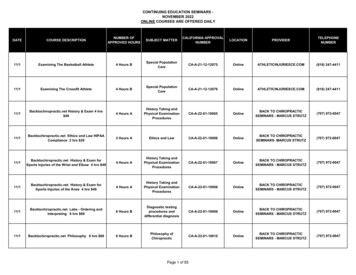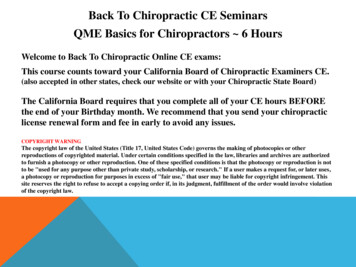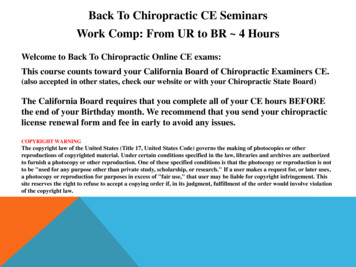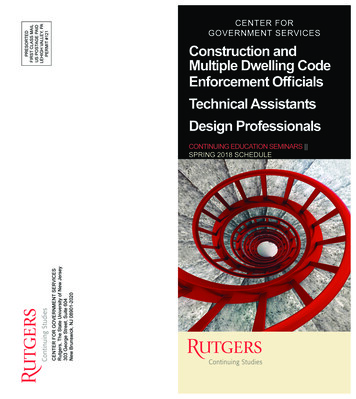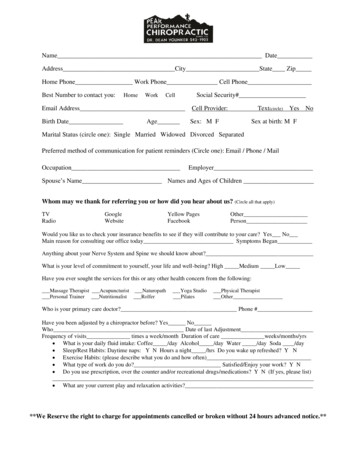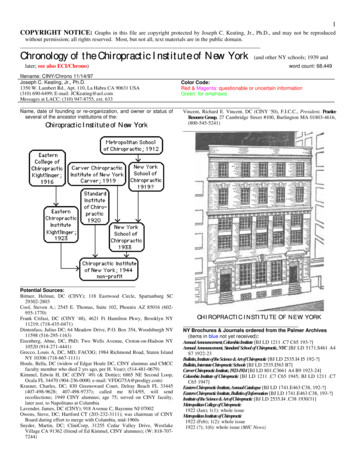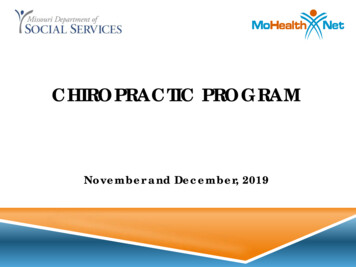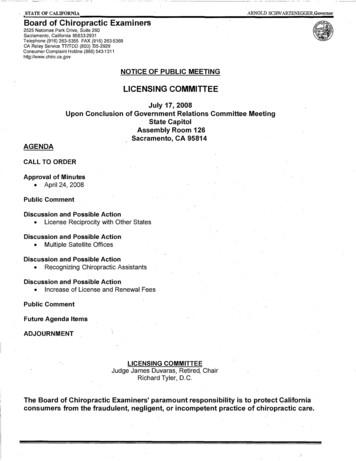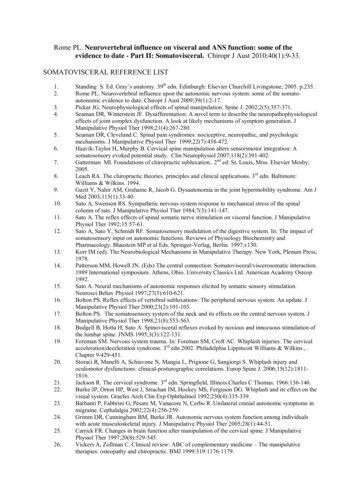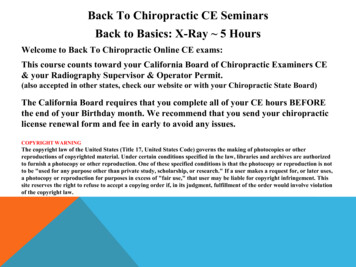
Transcription
Back To Chiropractic CE SeminarsBack to Basics: X-Ray 5 HoursWelcome to Back To Chiropractic Online CE exams:This course counts toward your California Board of Chiropractic Examiners CE& your Radiography Supervisor & Operator Permit.(also accepted in other states, check our website or with your Chiropractic State Board)The California Board requires that you complete all of your CE hours BEFOREthe end of your Birthday month. We recommend that you send your chiropracticlicense renewal form and fee in early to avoid any issues.COPYRIGHT WARNINGThe copyright law of the United States (Title 17, United States Code) governs the making of photocopies or otherreproductions of copyrighted material. Under certain conditions specified in the law, libraries and archives are authorizedto furnish a photocopy or other reproduction. One of these specified conditions is that the photocopy or reproduction is notto be "used for any purpose other than private study, scholarship, or research." If a user makes a request for, or later uses,a photocopy or reproduction for purposes in excess of "fair use," that user may be liable for copyright infringement. Thissite reserves the right to refuse to accept a copying order if, in its judgment, fulfillment of the order would involve violationof the copyright law.
Exam Process: Please read all instructions before starting!1. You must register/pay first. If you haven't, please return to: backtochiropractic.net2. Open a new window or a new internet tab & drag it so it's side-by-side next to this page.3. On the new window or new tab you just opened, go to: backtochiropractic.net website.4. Go directly to the Online section. DON'T register again.5. Click on the Exam for the course you want to take. No passwords needed.6. Follow the Exam instructions.7. Upon passing the exam you’ll be able to immediately download your certificate,and it’ll also be emailed to you. If you don’t pass, you can repeat the exam at no charge.Please retain the certificate for 4 years.If you get audited and lose your records, I’ll have a copy.I’m always a phone call away. 707.972.0047 or email: marcusstrutzdc@gmail.comMarcus Strutz, DCBack To Chiropractic CE Seminars
CERVICAL, THORACIC & LUMBARSPINEBack to Basics 5HrsJennifer Pedley, MS, DC, CCSP, DACBRChiropractic Radiologistwww.jprad.com
Radiographic Positioning & FactorsCervical spine Thoracic spine Lumbar spine Radiographic Evaluation— tools you canuseCervical spine Thoracic spine Lumbar spine
Cervical Spine Views3 Views APOM, AP lower cervical, and neutrallateral performed first; standard views If needed, Followed by extended andflexed lateral views evaluate forligamentous laxity and/or instability Obliqueviews are helpful in evaluating theintervertebral foramina
APOM FFD40” CRuvula; ifneeded, 5 degree withcephalad tubetilt Collimate 5x5Image
AP OPEN MOUTHStructures Visualized: Dens C1lateral masses Occipital C2body C2SPCondyles
AP Lower Cervical FFDTube Tilt15 cephalad40-3” CRC3/4(thyroid cartilage) Collimate7x10
Tube Tilt Rule For every 5 degreesof tube tilt, move xraytube one inch closerto the patient 15 degree tube tilt move tube closer by 3inches (40 inches to37 inches)
AP LOWER CERVICALStructures Visualized VertebralBodies TP’s SP’s UpperRibs UpperLung Fields UncinateProcesses TrachealAir Shadow
NEUTRAL LATERAL FFD72” CRC3 Collimate7X10
LATERAL CERVICALStructures Visualized Vertebral Discbodies C2-T1Spaces ADI SP’s,Lamina, Pedicles, ArticularPillars and Facets TrachealAir Shadow George’sLine & Spino-laminar line Sella C1TurcicaArches
LATERAL EXTENDED FFD72” CRC3 Collimate8x10May need to belandscape in patientswith greater range ofmotion
LATERAL FLEXED FFD72” CRC3 Collimate8x10 Mayneed to be landscape inpatients with great range ofmotion
Posterior vs. AnteriorObliquesPosterior Visualize theopposite IVF’s Example: Leftposterior obliqueradiograph,visualizes the rightIVF.Anterior Visualize thesame side IVF’s Example: Rightanterior obliqueradiograph,visualizes the rightIVF.
LEFT ANTERIOR OBLIQUE FFD72” CRC3 Tubetiltcaudad**15 Collimate7-8x10
LEFT POSTERIOR OBLIQUE FFDCR72-3”C3 Tube tilt 15 cephalad*** Collimate 7-8x10
CERVICAL OBLIQUEStructures Visualized IVF’s-should be openand about the same sizeat every level. Vertebral C1Bodiesarches Ribs SP’s Facets
Evaluation: ABC’S Alignment Bone Cartilage Soft tissue
Alignment- ABC’sLines of interest Posture Lordosis
Lines of Interest Spinolaminar line (green) Posterior cervical line(blue)Anterior cervical line (red)These lines should draw in asmooth arc. If there isdisruption of these lines,then further evaluation ofthe bony structures isrequired.
Radiographic Signs of Instability(Evaluate on the lateral radiographs) Vertebral body displacement 3-3.5mm Greater than 11 degree angulation Widened interlaminar & interspinous space Widened facet joints Widened interpediculate distance (AP view) Atlanto-dental interspace 3mm adults; 5mm in childrenThese findings indicate skeletal, ligamentous and articular disruption.AMA Guides, 5th ed.; Resnick D. Diagnosis of Bone and JointDisorders, 4th ed. 2002; 2936.www.radiologyassistant.nl
Measuring IntersegmentalTranslation- compare to the levelbelowGreater than 3-3.5 mmof vertebral bodymotion ligamentousinstabilityNeed to compare theflexed and extendedlateral to the neutrallateral radiograph.www.chiro-trust.org
Measuring Angulation Lines drawnon the Inferiorendplates. Greater 11degrees ligamentousinstabilitywww.chiro-trust.org
Other Evaluation Tips Spinous processes should be equidistant If widening or increased distance, indicator ofinterspinous ligament injury/disruption.Facet joints imbricated (stacked on top ofeach other )
More EvaluationADI-atlantodental interspace: V-shaped is normal Indicator of ligamentous instability(Transverse Ligament) with widening ofthe ADI on the Neutral lateral, or on theFlexed lateral, or on the Extended lateral. Greater than 5mm in children & greater than3mm in adults
Radiographic Signs ofInstability Vertebral body displacement 3-3.5mm Greater than 11 degree angulation Widened interlaminar & interspinous space Widened facet joints Widened interpediculate distance (AP view) Atlanto-dental interspace 3mm adults; 5mm in childrenThese findings indicate skeletal, ligamentous and articular disruption.AMA Guides, 5th ed.; Resnick D. Diagnosis of Bone and JointDisorders, 4th ed. 2002; 2936.
Evaluation CervicalGravity Line:Vertical linethrough apexof odontoid,shouldintersect C7
Cervical Gravity Line Gravity line anterior to C7 Anterior shift in weightbearingGravity line posterior to C7 Posterior shift in weightbearing
Evaluation Cervical LordosisAngle: Normal 3545 degree In this case, mildanterior shift inweightbearingYochum, T & Rowe, L. 2005.
Lordosis Angle Hypolordosis- loss of or straightening ofthe normal lordosis, less than 35 degrees. Hyperlordosis- increased lordosis, greaterthan 45 degrees.
Bone- ABC’s CortexShape and size of the vertebral bodies Should be same size at every level Pedicles and spinous process Example: compression deformity trauma or pathologic fromage related osteoporosis, primary bone tumor or metsMake sure they are there!!Equidistant to each otherIntervertebral foramina
Bone- continued Lateral masses of C1 and Dens of C2 Normal in shape and size with intact cortex
Cartilage-ABC’sJoints: Facet & Uncovertebral joints Shape, size and density Example:Sclerosis, narrowing and hypertrophied degenerative joint disease Intervertebral discs Size Example:Disc narrowing with/withoutspondylophytes degenerative disc disease
Soft Tissue- ABC’s Prevertebral or anterior soft tissues of thecervical spine Normal calcifications within the soft tissues Tracheal air shadow & Upper lung fields
Lateral cervical spine Evaluate the anteriorand posterior softtissues Prevertebral(anterior) soft tissues: Retropharyngeal: 7.0-mmRetrotracheal: 22.0mmwww.radiologyassistant.nl
Prevertebral Soft Tissues Why do we need to look at them? Widening of the anterior/ prevertebral softtissue and/or increased density Differentialdiagnosis is edema due to trauma, infection,or a mass/tumor.
Posterior Soft Tissues Don’t miss fractures of spinous processwhen evaluating the soft tissues Normal nuchal bones- calcification withinthe ligamentum nuchae, normalphysiologic variant.
Soft tissues-continued Normal calcification of the thyroid cartilage AP radiograph of cervical spineTracheal air shadow Upper lung field Lateral soft tissues Atherosclerosisof carotid arteries
Tracheal deviationto the right. The normaltracheal cartilagecalcification is alsodeviated to theright.
Atherosclerosis of bilateralcarotid arteries
2 Views of the Thoracic Spine AP and Lateral views PA chest view is optional With full inspiratory effort
AP Thoracic Projection FFD40” CRT6 Collimate7x17
Lateral Thoracic View FFDCR Collimate 10x17 Take imageduring expirationto blur out theribs 40”T6
AP and Lateral ThoracicViewswww.mypacs.net
Evaluation: ABC’S Alignment Bone Cartilage Soft tissue
Alignment-ABC’s PostureConvexities Scoliosis If10-15 years of age, curve less than 20 degreesmaybe monitored, assess for progression of 5degrees or more in a 3 month timeframe. Curves 20-40 degrees may be surgical
Scoliosis Cobb-Lippman method of mensuration
Alignment-continued KyphosisNormal 20-40 degrees (increases with age) Hypokyphosis: less than 20 degrees Hyperkyphosis: more than 40 degrees
Bone- ABC’s Shape and size of vertebral bodies Intervertebral foramina Compression deformity fracture or normal morphologyEqual in sizeStenosis: degenerative posterior osteophyte, degenerative discdisease, facet degeneration, and/or degenerative retrolisthesis.Pedicles Missing pedicle aggressive pathology such as tumor ormetastatic disease
Bone-continued Spinous processes Make sure they are present, normal cortices,normal sizeIntervertebral foraminaMake sure they are clear and equal size Stenosis posterior osteophyte, degenerativedisc disease, degenerative retrolisthesis, facetdegeneration
Cartilage-ABC’s Disc spacing Facet joints Degenerative disc disease disc narrowing with orwithout spondylophytesHypertrophied and sclerosis degenerative jointdiseaseNormal costochondral cartilage calcification ofthe lower ribs
Soft tissues- ABC’s Chest Lung fields: check forradiopacities/nodules/tumors Tracheal air shadow No deviation; should be midlineAortic knob Atherosclerosis-age Normalin sizerelated
Soft tissue- continuedHemidiaphragm Megenblase should not be superior to the lefthemidiaphragm Hiatal hernia
Hiatal Hernia Air above the left hemidiaphragm
2-3 Views of the LumbarSpine AP LateralAngulated PA or AP lumbosacral spotviewor Lateral lumbosacral spot view
AP Lumbar Spine FFD40” CR1” aboveiliac crest Collimate 10 x17
Lateral Lumbar View FFD40” CR1” aboveiliac crest Collimate 11x17
AP and Lateral Viewswww.uwmsk.org
AP Angulated Lumbosacral FFD CR 40”-5”1” belowASISTube tilt 25-35 cephalad (25degrees caudad for PAangulation) Collimate 10x12
AP (PA) AngulatedLumbosacralStructures Visualized L5-S1 Disc Space Sacroiliac (SI) Joints: Bestradiograph to evaluate for the SIjoints Sacrum Sacral Foramen L5 TP's and SP's L5 Vertebral Body
(Left) Posterior Oblique View FFD40” CR1” aboveiliaccrest Collimate 11x14
Scotty Dog Nose Transverseprocess Eye Pedicle Ear Superior facet Front leg Inferior Collar thru the neck Fracturewww.imageinterpretation.co.uk
Evaluation: ABC’S Alignment Bone Cartilage Soft tissue
Alignment-ABC’s Anterior and posterior vertebral body line (lateralradiograph) Evaluate for anterolisthesis/retrolisthesis of thelumbar segment, compare to the level below. Cause of anterolisthesis degenerative changes or parsinterarticularis defect or fractureCause of retrolisthesis most commonly degenerativechangesPosture Gravity Line Anterior shift in weightbearingPosterior shift in weightbearing
Evaluation FergusonGravity Line:from center ofL3, shouldintersectanterior 1/3 ofsacrum
Evaluation Ferguson Gravity Line Anterior shift in weightbearing increasedstress on facet joints Posterior shift in weightbearing increasedstress on the IVF, pars interarticularis,facet joints & posterior disc.
Evaluation Normal Lordosis:50-60 degrees
Alignment- continued Lordosis Normal lordosis: 50-60 degreeHypolordosis: loss of the lumbar lordosis withstraightening.Hyperlordosis: increased lumbar lordosisScoliosis/convexities If 10-15 years of age, curve less than 20 degrees maybemonitored, assess for progression of 5 degrees or more in a3 month timeframe.Curves 20-40 degrees may be surgical
Bone- ABC’s Shape and size of vertebral bodies Compression deformitiesPedicles and spinous processMake sure they are present and in the correctlocation Fractures of pedicles Spina bifida occulta, normal variant.
Normal spina bifida occulta No fusion at the junction ofthe lamina and spinousprocess Posterior cleft
Bone-continued Pars interarticularisDefect/fracture Classification of pars interarticularisdefects/fractures Gradeof spondylolisthesis (anterolisthesis)
Cause of AnterolisthesisTypes/Causes Type 1: Dysplastic (congenital) Type 2: Isthmic 2a fatigue fracture of the pars interarticularis2b elongation of the pars2c acute fracture of the pars Type 3: Degenerative disc disease or degenerativefacet joints Type 4: Traumatic, fractures to the neural arch Type 5: Pathologic, bone disease
Grade of Spondylolisthesis Grade 1 spondylolyticspondylolisthesis at L5 MeyerdingClassification: Grade 1-4Dr. Terry Yochum, DC, DACBR
Bone- continued Intervertebral foraminaMake sure they are clear and equal size Stenosis posterior osteophyte, degenerativedisc disease, degenerative retrolisthesis,and/or facet degeneration.
Bone-continued Lower ribs Normal costochondral cartilage calcification Sacrum/Ilium Hips-femur and acetabulum if included inthe AP lumbar study
Cartilage-ABC’s Facet joints Degenerative changesSacroiliac jointsDegenerative changes bony proliferation,sclerosis and joint narrowing. Inflammatory (ankylosing spondylitis) bilateralerosive changes, widening of the joint; orcomplete fusion
Cartilage-continued Transitional segmentsL5 sacralization S1 lumbarization Classification Intervertebral discs Disc spacing narrowing with/withoutspondylophytes is degenerative changes.
TRANSITIONALSEGMENT AT L5L5
Transitional Segment at L5 Sacralization of L5 Bilateral pseudoarthrosis,articulation to the sacrum, IIb Castellvi Complication Increased stress above andbelow Early degenerative discdisease at L4-L5.
Castellvi Types Type II and IVassociated with lowback pain Bertolotti’s syndromeinflamed transitionalsegment. Clinicallymisdiagnosed assacroilitis.
Soft tissues- ABC’s Anterior soft tissues Atherosclerosis of abdominal aorta, iliac arteries Gallstones: right upper abdominal quadrant, AND anterior to thespineKidney stones: right or lower abdominal quadrant, but overlies oradjacent to the spine.Lower lung field Calcification of abdominal aorta: width of abdominal aorta shouldnot exceed 2.0 cm (lateral radiograph)Check for radiopacities or tumors/massesBowel gas
Atherosclerosis of abdominalaorta Wideningofabdominalaorta,greaterthan 4.5 cm
Soft tissues-continued Organ shadows Kidney: calcifications/stonesLiver: Enlarged (hepatomegaly)Spleen: Enlarged (splenomegaly); extending inferiorlyfrom the left 12th rib.Pelvic basin Bladder shadow: Distended prostate pathologyUterine fibroids (benign calcifications)Vas deferens calcification V-shaped tubularcalcification within the mid portion of pelvic basin Associated with diabetes
Splenomegaly
Hepatomegaly
Vas Deferens Calcification
Soft tissues-continued Surgical artifact within the abdomen andpelvic basinCholecystectomy (gallbladder removal) Vascular clips Intrauterine device
www.jprad.com700 East Redlands Blvd, Redlands CA. 92373312.218.1358 jpedley299@yahoo.com
Thanks for taking CE Seminars with Back To Chiropractic.I hope you enjoyed the course. Please feel free to provide feedback.Check out: Back To Chiropractic ResourcesFree Materials: Notes & Forms hundreds of files posters, newsletters & moreServices & Listings People helping people for freeMarcus Strutz DCBack To Chiropractic CE Seminarsmarcusstrutzdc@gmail.com707.972.0047
Welcome to Back To Chiropractic Online CE exams: This course counts toward your California Board of Chiropractic Examiners CE & your Radiography Supervisor & Operator Permit. (also accepted in other states, check our website or with your Chiropractic State Board) The California Board requires that you complete all of your CE hours BEFORE the .

